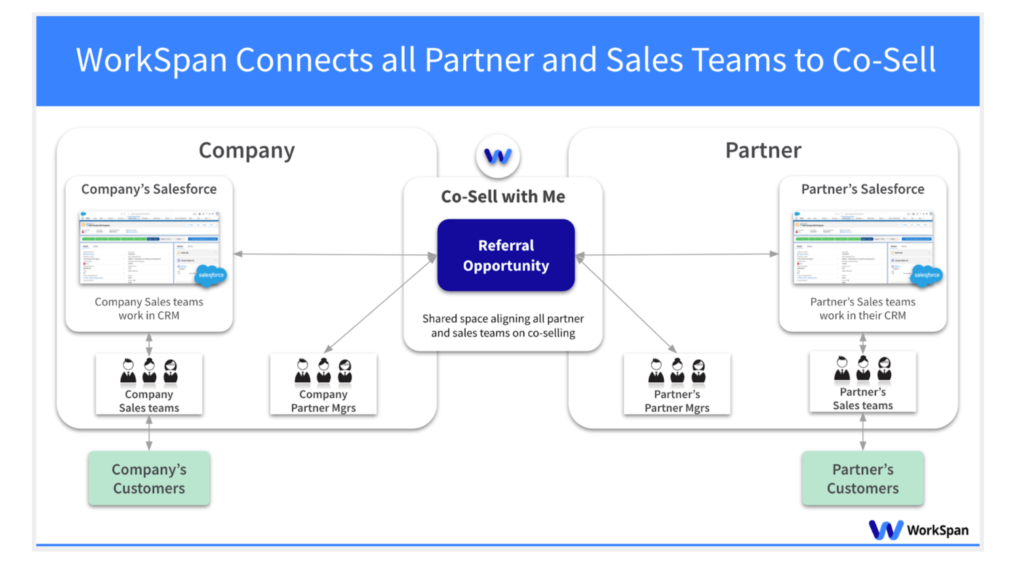
Technology is evolving rapidly, and the marketplace is more competitive than ever before. A recent survey by Accenture shows that 84% global executives believe partner ecosystems are vital to their business strategy and allow them to grow in ways not possible otherwise. The Decade of Ecosystems has arrived, and companies can use partner ecosystems for competitive advantage.
Companies need to connect with their ecosystem partners with a seamless and interconnected system so that all partners can adapt quickly to demand changes and offer agile solutions to customers. Active collaboration in a partner ecosystem will improve customer experience and grow your business rapidly.
In the past, companies used partner relationship management tools and similar portal solutions, but they were designed and built when companies focused on attracting partners to resell their solutions. Today, growing your ecosystem of partners to co-sell with is critical to winning in the market. Your best opportunity will be to invest in a fast and effective ecosystem business management solution to co-sell with your partners, bring out the best of partnerships, and boost revenue.
This blog explains ecosystem business management solutions and traditional PRMs and shows how they are different from each other.
What is a Partner Relationship Management Tool?
A PRM or Partner Relationship Management tool helps organizations automate and streamline their distributor, reseller, MSPs, and VAR partner activities like tracking operations, inventory, pricing, and discounts. In addition, such tools help in easy and efficient sales management, focusing on reselling products and services with various channel partners.
PRM tools were developed over the last decade and are mainly used to manage traditional reseller-focused partnerships. Standard Features of PRM Tool include – Partner Portal; Lead Management; Marketing Campaigns, Training, and Performance; Admin controls; Dashboard; and Communication Tools. Please read our detailed PRM guide to learn more about PRM solutions.
What is an Ecosystem Business Management Tool?
As the market has evolved from reselling to partner co-selling,, partner relationship management tools are no longer effective. PRMs simply don’t support the processes needed to co-sell with your ecosystem partners. So what you’ll find is that partner managers that are co-selling with partners are using spreadsheets to manage their shared pipeline, and not using their PRM - even when the company has spent hundreds of thousands of dollars (or more) to put a PRM in place.
Co-selling with partners is the new norm in today’s cloud-computing world, where everything is in the cloud, joint solutions are commonplace, and your job as a partner manager is to align field teams across companies. With the right EBM solution for co-selling, companies can share information, manage their shared pipelines of co-sell opportunities, take part in co-innovation projects, and much more with their ecosystem partners.
Companies can connect a set of predefined fields from their CRM with their partners’ CRM through a shared network and get secure data visibility. Companies connect as peers on a network, connecting to whichever partner they need to at any time to build a trusted relationship and co-sell together.
Difference between a Partner Relationship Management and an Ecosystem Business Management Platform
PRM tools and partner portals are not the solution for a company to manage ecosystem partners. An EBM platform allows co-selling and active collaboration that outdated partner portals are not architecturally able to offer.

There are a lot of differences between the two platforms. Here are some of them:
1. Partner relationship management tools mainly focused on managing channel sales through reseller partnerships. They do not allow collaboration with a partner ecosystem for co-sell deals. As there are no joint activities supported, PRMs don’t allow tracking and measuring co-sell opportunities. You cannot use PRM tools for co-sell motions and partner managers typically resort to manual spreadsheets.
Additionally, you know that with the 80/20 rule, almost 80% of revenue is driven by your top strategic partners, and most companies are co-selling with their top partners. Partner portals can handle the “long tail” of the many small partners that are reselling your solutions and makeup 80% of your partners (but only 20% of your revenue!) So why invest so much money focusing on 20% of your partner revenue (long-tail partners) in a solution that can’t handle the top partners driving 80%?
2. PRM tools just align with your company’s resellers, VARs, distributors, etc., and not with co-sell partners like software partners, MSPs, service partners, ISVs, cloud, or hardware partners. All these partnerships require a purpose-built EBM solution to manage and drive co-sell motions.
Through an ecosystem business management solution, your company’s CRM can be connected to your partners’ CRM to securely share selected information. Companies can use this to work on joint opportunities by monitoring the partner’s side of transactions, various deal sizes, and different SKUs. Aligned CRMs offer joint account planning and endless co-sell opportunities. Co-selling becomes easier because of easy data interoperability and efficiently managing the co-sell process across companies to drive deals forward.

3. PRMs and partner portals just help in dealing with reseller partners where every deal has one opportunity, deal size, and just a single win or loss outcome. It is limited to this and does not support the different states involved in a co-sell deal.
EBMs are able to handle co-sell deals because each partner has their services and products, different sales stages, different deal sizes, etc. A co-sell opportunity is not one-dimensional and can be win-win, loss-loss, win-loss, or loss-win. Partner portals don’t have the functionality required to handle co-sell deals.
4. Partner relationship management tools don’t allow P2P collaboration and are one-directional. A single partner hosts the portal and owns all security rights and data. Other members need to log in to access and upload any data. And just imagine as a partner working with 20-30 other partners, you have to log into 20-30 different portals, but you have your own portal - so who logs into who’s portal? It’s an outdated and cumbersome process, and the result is that, even when companies have invested in a PRM, they are actually rarely used by partners.
An EMB platform is a common ground in which the company and its partners can work as peers and actively collaborate on co-innovating and co-selling opportunities.
Conclusion
Most companies are stuck on outdated partner relationship management tools, and it has become difficult for them to stay updated with the ever-changing partner ecosystem landscape. This can lead to severe consequences, and partners may also switch over to competitors if your company does not leverage and value them properly.
An ecosystem business management platform has everything that a PRM tool lacks and allows for better, more-productive collaboration among partners. Companies can co-innovate and take part in co-sell opportunities effectively with partners and offer innovative solutions to customers.
For better channel management, it is high time to learn more about digitizing, optimizing, and scaling your partner managers for co-selling with an EBM solution.
Heading
Heading 1
Heading 2
Heading 3
Heading 4
Heading 5
Heading 6
Lorem ipsum dolor sit amet, consectetur adipiscing elit, sed do eiusmod tempor incididunt ut labore et dolore magna aliqua. Ut enim ad minim veniam, quis nostrud exercitation ullamco laboris nisi ut aliquip ex ea commodo consequat. Duis aute irure dolor in reprehenderit in voluptate velit esse cillum dolore eu fugiat nulla pariatur.
Block quote
Ordered list
- Item 1
- Item 2
- Item 3
Unordered list
- Item A
- Item B
- Item C
Bold text
Emphasis
Superscript
Subscript





.png)